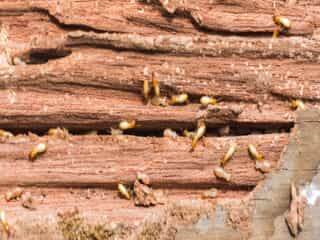Termites rank as one of the most destructive insect pests in the world and are classified as invasive insects. They wreak havoc on the bones of your home and cause more than $5 billion in damage annually in the United States alone. Formosan subterranean termites cause 1/3 of the total damage created by invasive insects and only exist within 40 degrees north and south of the Equator. As residents of Southeast Georgia, we reside in a hot spot for Formosan termites, making the thought of not staying up-to-date on your termite protection and warranty a terrifying one.

Termite Fast Fact 1
Not all termites are created equal. There are 3 different types of termites –Drywood, Dampwood and Subterranean. Subterranean termites include the Formosan variety and as their name implies, they infest homes from the ground up; directly into damp or damaged wood; or through mud tubes they’ve constructed along concrete foundations or in crawlspaces.
In Southeast Georgia, we focus on Eastern Subterranean and Formosan termites as they cause the most destruction in our area. It’s important to note a few key differences between the 2 species:
- Physical appearance – Formosan termites have a longer body and a shorter head with two short pinchers. Eastern Subterranean termites have a longer head and bodies with long pinchers. Both have long wings and look like flying ants in their swarmer form, which is when they go out looking for mates to reproduce their colonies. If you happen to see winged termites flying around the doors and windows, chances are high that you have an infestation nearby. (Check out Termite Fast Fact 3 for differentiating characters between termites and carpenter ants).
- Color – Formosan termites have a translucent orange color while the Eastern Subterranean species has a translucent gray/brown color.
- Main disparity between the 2 species – Formosan termites build cartons that bring moisture to their nests. This ability allows them to build nests without having to return to the soil for moisture, making them much more efficient in their working order. Not having to take the additional step of returning to the soil – like Eastern Subterranean termites do – allows the colonies to grow at a much more rapid pace. This is why they are so much more destructive!
Termite Fast Fact 2
Termites have been causing damage and destruction in the United States and North America since well before the Europeans arrived. There is even fossil evidence that they existed during the Cretaceous period. It’s clear that they aren’t going anywhere anytime soon! Termites cause more damage every year than earthquakes, house fires and hurricanes combined. And homeowner’s insurance doesn’t cover termite damage. That’s where we come in. We’ve been serving Southeast Georgia since 1928 and are proud to provide the best termite warranty in the industry.
Termite Fast Fact 3
Termites are commonly mistaken for carpenter ants. Not sure what pest you’re dealing with? Look for the following differentiating characteristics:
- Carpenter ants have a narrow waist compared to a termite’s notably solid body.
- Termites have uniform symmetrical wings, whereas carpenter ants have unequal wings.
- Carpenter ants have elbowed antennae while termites are straight.
- Once termites find a place to build their nest, they shed their wings.
Termite Fast Fact 4
Termites eat wood from the inside out to build their colonies, so you may not even know you have them until your home has encountered significant structural damage. A mature colony will have a large number of feeding and nesting sites all connected by tunnels. One single colony can consist of more than a million termites and can spread across half an acre of land. These pests may be small but they are incredibly mighty and destructive!
Termite Fast Fact 5
Termite control requires the skill of a professional. In order to eliminate termites, specific equipment and pesticides are required and the only sure-fire way to do this is with professional treatment.
Don’t leave one of your most valuable possessions vulnerable to a termite infestation. Be sure to maintain your termite protection year after year or consider adding it. When it comes to termites in Southeast Georgia, it’s not a matter of “if” but a matter of “when”. Contact us for a free termite inspection and to determine which treatment program best meets your needs.
